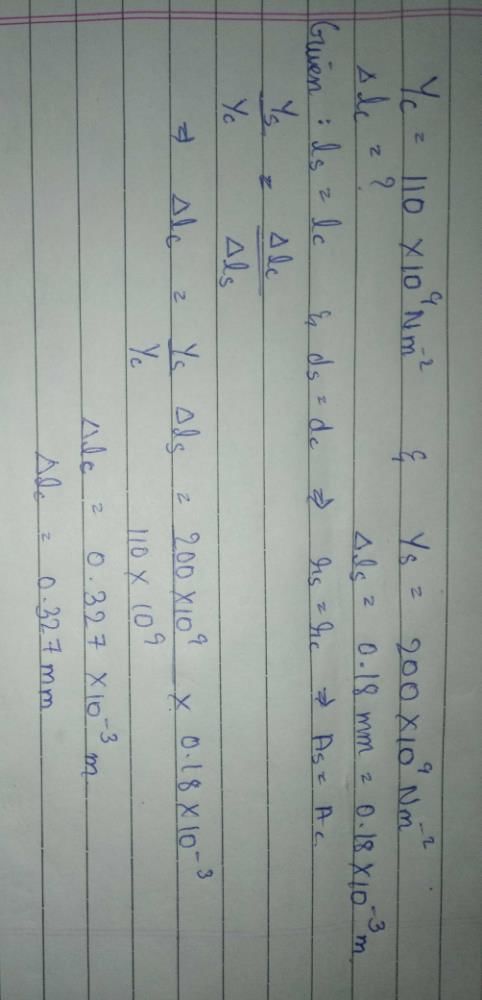Class 11 Exam > Class 11 Questions > You hang a flood lamp from the end of a verti...
Start Learning for Free
You hang a flood lamp from the end of a vertical steel wire. The flood lamp stretches the wire 0.18 mm and the stress is proportional to the strain. How much would it have stretched for a copper wire of the original length and diameter?
- a)0.39 mm
- b)0.37 mm
- c)0.33 mm
- d)0.18 mm
Correct answer is option 'C'. Can you explain this answer?
Most Upvoted Answer
You hang a flood lamp from the end of a vertical steel wire. The flood...

Free Test
FREE
| Start Free Test |
Community Answer
You hang a flood lamp from the end of a vertical steel wire. The flood...
Given:
Stress is proportional to strain.
The flood lamp stretches the steel wire by 0.18 mm.
We need to find the amount of stretch for a copper wire of the original length and diameter.
Solution:
Let us assume that the stress in both the wires is the same.
Let L be the original length of the wire and d be the diameter of the wire.
Let δ be the amount of stretch in the copper wire.
The stress in the wire is given by:
Stress = Force/Area
The force on the wire is due to the weight of the flood lamp. Let W be the weight of the flood lamp.
Force = W
The area of the wire is given by:
Area = πd²/4
The strain in the wire is given by:
Strain = δ/L
Since stress is proportional to strain, we have:
Stress in steel wire/Strain in steel wire = Stress in copper wire/Strain in copper wire
Therefore,
Stress in copper wire = (Stress in steel wire/Strain in steel wire) x Strain in copper wire
We know that the stress in steel wire is proportional to the strain in steel wire. Therefore,
Stress in steel wire/Strain in steel wire = constant
Let this constant be k. Then,
Stress in steel wire = k x Strain in steel wire
Substituting these values in the above equation, we get:
k x Strain in steel wire/Strain in copper wire = Stress in copper wire/Strain in copper wire
Stress in copper wire = k x Strain in steel wire x (Strain in copper wire/Strain in steel wire)
Substituting the values of stress, force, and area in terms of W, δ, L, and d, we get:
(W/πd²/4) = k x (0.18/L) x (δ/L) x (d/0.18)
δ = (W/πd²/4) x (L/0.18) x (0.18/d) x (1/k)
We know that the stress in steel wire is proportional to strain. Therefore,
Stress in steel wire/Strain in steel wire = constant
For steel, the value of this constant is approximately 200 GPa.
Therefore, k = 200 GPa
Substituting the values of W, L, d, and k in the above equation, we get:
δ = (W/πd²/4) x (L/0.18) x (0.18/d) x (1/200 GPa)
δ = (W/πd²/4) x (L/d) x (1/200 GPa)
δ = (W/πd²/4) x (L/d) x (5 x 10^-6)
Substituting the values of W, L, and d, we get:
δ = (60 N/π(2 x 10^-3 m)²/4) x (2 m/(1.2 x 10^-3 m)) x (5 x 10^-6)
δ = 0.33 mm
Therefore, the amount of stretch in the copper wire is 0.33 mm.
Hence, option (c) is the correct answer.
Stress is proportional to strain.
The flood lamp stretches the steel wire by 0.18 mm.
We need to find the amount of stretch for a copper wire of the original length and diameter.
Solution:
Let us assume that the stress in both the wires is the same.
Let L be the original length of the wire and d be the diameter of the wire.
Let δ be the amount of stretch in the copper wire.
The stress in the wire is given by:
Stress = Force/Area
The force on the wire is due to the weight of the flood lamp. Let W be the weight of the flood lamp.
Force = W
The area of the wire is given by:
Area = πd²/4
The strain in the wire is given by:
Strain = δ/L
Since stress is proportional to strain, we have:
Stress in steel wire/Strain in steel wire = Stress in copper wire/Strain in copper wire
Therefore,
Stress in copper wire = (Stress in steel wire/Strain in steel wire) x Strain in copper wire
We know that the stress in steel wire is proportional to the strain in steel wire. Therefore,
Stress in steel wire/Strain in steel wire = constant
Let this constant be k. Then,
Stress in steel wire = k x Strain in steel wire
Substituting these values in the above equation, we get:
k x Strain in steel wire/Strain in copper wire = Stress in copper wire/Strain in copper wire
Stress in copper wire = k x Strain in steel wire x (Strain in copper wire/Strain in steel wire)
Substituting the values of stress, force, and area in terms of W, δ, L, and d, we get:
(W/πd²/4) = k x (0.18/L) x (δ/L) x (d/0.18)
δ = (W/πd²/4) x (L/0.18) x (0.18/d) x (1/k)
We know that the stress in steel wire is proportional to strain. Therefore,
Stress in steel wire/Strain in steel wire = constant
For steel, the value of this constant is approximately 200 GPa.
Therefore, k = 200 GPa
Substituting the values of W, L, d, and k in the above equation, we get:
δ = (W/πd²/4) x (L/0.18) x (0.18/d) x (1/200 GPa)
δ = (W/πd²/4) x (L/d) x (1/200 GPa)
δ = (W/πd²/4) x (L/d) x (5 x 10^-6)
Substituting the values of W, L, and d, we get:
δ = (60 N/π(2 x 10^-3 m)²/4) x (2 m/(1.2 x 10^-3 m)) x (5 x 10^-6)
δ = 0.33 mm
Therefore, the amount of stretch in the copper wire is 0.33 mm.
Hence, option (c) is the correct answer.

|
Explore Courses for Class 11 exam
|

|
Question Description
You hang a flood lamp from the end of a vertical steel wire. The flood lamp stretches the wire 0.18 mm and the stress is proportional to the strain. How much would it have stretched for a copper wire of the original length and diameter?a)0.39 mmb)0.37 mmc)0.33 mmd)0.18 mmCorrect answer is option 'C'. Can you explain this answer? for Class 11 2025 is part of Class 11 preparation. The Question and answers have been prepared according to the Class 11 exam syllabus. Information about You hang a flood lamp from the end of a vertical steel wire. The flood lamp stretches the wire 0.18 mm and the stress is proportional to the strain. How much would it have stretched for a copper wire of the original length and diameter?a)0.39 mmb)0.37 mmc)0.33 mmd)0.18 mmCorrect answer is option 'C'. Can you explain this answer? covers all topics & solutions for Class 11 2025 Exam. Find important definitions, questions, meanings, examples, exercises and tests below for You hang a flood lamp from the end of a vertical steel wire. The flood lamp stretches the wire 0.18 mm and the stress is proportional to the strain. How much would it have stretched for a copper wire of the original length and diameter?a)0.39 mmb)0.37 mmc)0.33 mmd)0.18 mmCorrect answer is option 'C'. Can you explain this answer?.
You hang a flood lamp from the end of a vertical steel wire. The flood lamp stretches the wire 0.18 mm and the stress is proportional to the strain. How much would it have stretched for a copper wire of the original length and diameter?a)0.39 mmb)0.37 mmc)0.33 mmd)0.18 mmCorrect answer is option 'C'. Can you explain this answer? for Class 11 2025 is part of Class 11 preparation. The Question and answers have been prepared according to the Class 11 exam syllabus. Information about You hang a flood lamp from the end of a vertical steel wire. The flood lamp stretches the wire 0.18 mm and the stress is proportional to the strain. How much would it have stretched for a copper wire of the original length and diameter?a)0.39 mmb)0.37 mmc)0.33 mmd)0.18 mmCorrect answer is option 'C'. Can you explain this answer? covers all topics & solutions for Class 11 2025 Exam. Find important definitions, questions, meanings, examples, exercises and tests below for You hang a flood lamp from the end of a vertical steel wire. The flood lamp stretches the wire 0.18 mm and the stress is proportional to the strain. How much would it have stretched for a copper wire of the original length and diameter?a)0.39 mmb)0.37 mmc)0.33 mmd)0.18 mmCorrect answer is option 'C'. Can you explain this answer?.
Solutions for You hang a flood lamp from the end of a vertical steel wire. The flood lamp stretches the wire 0.18 mm and the stress is proportional to the strain. How much would it have stretched for a copper wire of the original length and diameter?a)0.39 mmb)0.37 mmc)0.33 mmd)0.18 mmCorrect answer is option 'C'. Can you explain this answer? in English & in Hindi are available as part of our courses for Class 11.
Download more important topics, notes, lectures and mock test series for Class 11 Exam by signing up for free.
Here you can find the meaning of You hang a flood lamp from the end of a vertical steel wire. The flood lamp stretches the wire 0.18 mm and the stress is proportional to the strain. How much would it have stretched for a copper wire of the original length and diameter?a)0.39 mmb)0.37 mmc)0.33 mmd)0.18 mmCorrect answer is option 'C'. Can you explain this answer? defined & explained in the simplest way possible. Besides giving the explanation of
You hang a flood lamp from the end of a vertical steel wire. The flood lamp stretches the wire 0.18 mm and the stress is proportional to the strain. How much would it have stretched for a copper wire of the original length and diameter?a)0.39 mmb)0.37 mmc)0.33 mmd)0.18 mmCorrect answer is option 'C'. Can you explain this answer?, a detailed solution for You hang a flood lamp from the end of a vertical steel wire. The flood lamp stretches the wire 0.18 mm and the stress is proportional to the strain. How much would it have stretched for a copper wire of the original length and diameter?a)0.39 mmb)0.37 mmc)0.33 mmd)0.18 mmCorrect answer is option 'C'. Can you explain this answer? has been provided alongside types of You hang a flood lamp from the end of a vertical steel wire. The flood lamp stretches the wire 0.18 mm and the stress is proportional to the strain. How much would it have stretched for a copper wire of the original length and diameter?a)0.39 mmb)0.37 mmc)0.33 mmd)0.18 mmCorrect answer is option 'C'. Can you explain this answer? theory, EduRev gives you an
ample number of questions to practice You hang a flood lamp from the end of a vertical steel wire. The flood lamp stretches the wire 0.18 mm and the stress is proportional to the strain. How much would it have stretched for a copper wire of the original length and diameter?a)0.39 mmb)0.37 mmc)0.33 mmd)0.18 mmCorrect answer is option 'C'. Can you explain this answer? tests, examples and also practice Class 11 tests.

|
Explore Courses for Class 11 exam
|

|
Signup for Free!
Signup to see your scores go up within 7 days! Learn & Practice with 1000+ FREE Notes, Videos & Tests.


















